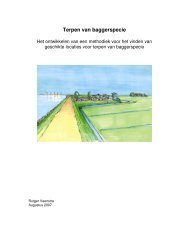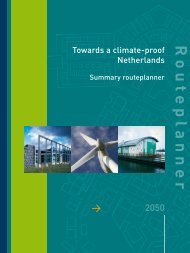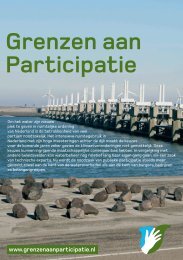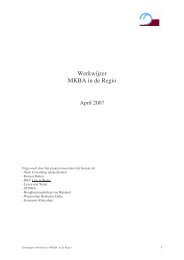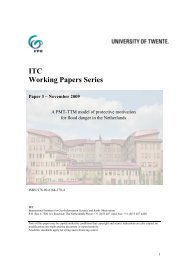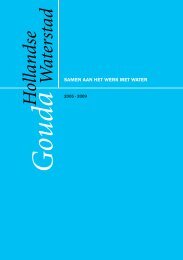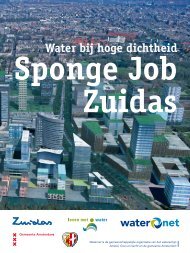KvR report 001/2006The outputs <strong>of</strong> this scoping study are threefold:- a background report (this report);- a flyer <strong>with</strong> a brief descripti<strong>on</strong> <strong>of</strong> <strong>the</strong> findings;- a website http://ivm10.ivm.vu.nl/<strong>deltas</strong> <strong>with</strong> informati<strong>on</strong> <strong>on</strong> delta’s and how <strong>the</strong>semay be affected by <strong>climate</strong> change.This study should be <strong>of</strong> use to a wide array <strong>of</strong> pr<strong>of</strong>essi<strong>on</strong>als, instituti<strong>on</strong>s, policymakers and ngo's, who are c<strong>on</strong>cerned <strong>with</strong> <strong>the</strong> future <strong>of</strong> delta's. It is hoped howeverthat already <strong>the</strong> results <strong>of</strong> phase 1 will provide first guidance in development <strong>of</strong>system-based measures for dredging companies, ngo’s and (multi-lateral) fundinginstituti<strong>on</strong>s. The scoping study will roughly outline which <strong>deltas</strong> are still functi<strong>on</strong>ing ina more or less natural manner - or could be (re)developed in that directi<strong>on</strong> - andthus would be good candidates for a system-based approach.What is not covered by this scoping study?It could well be true that in many <strong>deltas</strong> eventually a combinati<strong>on</strong> <strong>of</strong> technical andsystem-based measures is <strong>the</strong> best approach. In order to make an objective choice(or strike a balance) between a system-based approach and technical measures, amore complete picture <strong>of</strong> <strong>the</strong> advantages and disadvantages <strong>of</strong> both approaches willbe necessary, including a cost-benefit analysis which covers both <strong>the</strong> social andec<strong>on</strong>omic <strong>effects</strong>. Such comparis<strong>on</strong>s are bey<strong>on</strong>d <strong>the</strong> s<strong>cope</strong> <strong>of</strong> this definiti<strong>on</strong> studybut could be part <strong>of</strong> research in <strong>the</strong> following phases (see paragraph <strong>on</strong> objectivesand outputs below), possibly as part <strong>of</strong> <strong>the</strong> umbrella-project “Water-Kust” (Water-Coast) currently being set up by <strong>the</strong> Ministry <strong>of</strong> Transport, Public Works and WaterManagement.In <strong>deltas</strong> which have been str<strong>on</strong>gly developed in ec<strong>on</strong>omic terms (harbors, oilrefineries, cities, etc.) <strong>the</strong> possibility for a system-based approach may be differentfrom <strong>deltas</strong> <strong>with</strong> <strong>on</strong>ly a few settlements. On <strong>the</strong> <strong>on</strong>e hand larger sums <strong>of</strong> m<strong>on</strong>ey foradaptive measures (ei<strong>the</strong>r technical or system-based) will be available in highlydeveloped <strong>deltas</strong> and <strong>on</strong> <strong>the</strong> o<strong>the</strong>r hand special c<strong>on</strong>diti<strong>on</strong>s and <strong>the</strong> attitude <strong>of</strong> <strong>the</strong>people in <strong>the</strong> area may reduce <strong>the</strong> chances <strong>of</strong> success. The opposite is probably truein less-developed areas. The limited s<strong>cope</strong> <strong>of</strong> this study did not allow for aquantitative approach <strong>of</strong> this issue – it is <strong>on</strong>ly briefly touched up<strong>on</strong> in a qualitativemanner.2. <str<strong>on</strong>g>Deltas</str<strong>on</strong>g><str<strong>on</strong>g>Deltas</str<strong>on</strong>g> <strong>on</strong> <strong>the</strong> <strong>move</strong><str<strong>on</strong>g>Deltas</str<strong>on</strong>g> are found where rivers meet <strong>the</strong> sea. In this highly dynamic envir<strong>on</strong>ment <strong>the</strong>yare able to develop and sustain <strong>the</strong>mselves. They owe <strong>the</strong>ir very existence to <strong>the</strong>forces <strong>of</strong> waves, tidal currents and river flows. This chapter describes <strong>the</strong>geomorphological and ecological processes in a delta. Understanding <strong>the</strong>seprocesses is <strong>of</strong> key importance when trying to find ways to maintain, restore or evenenhance a delta’s capacity to <strong>cope</strong> <strong>with</strong> <strong>the</strong> <strong>effects</strong> <strong>of</strong> <strong>climate</strong> change.2.1 <str<strong>on</strong>g>Deltas</str<strong>on</strong>g> <strong>of</strong> <strong>the</strong> world<str<strong>on</strong>g>Deltas</str<strong>on</strong>g> are a worldwide phenomen<strong>on</strong>, <strong>the</strong>y occur from <strong>the</strong> arctic regi<strong>on</strong> to <strong>the</strong> tropics.Some <strong>of</strong> <strong>the</strong> world’s greatest rivers have built massive <strong>deltas</strong> at <strong>the</strong>ir mouths. Themost famous is that <strong>of</strong> <strong>the</strong> Nile River. The term “delta” is derived from <strong>the</strong> mouth <strong>of</strong><strong>the</strong> Nile as it has a characteristic triangular shape, like <strong>the</strong> Greek capital letter delta(∆, see photo).Most rivers flow into a sea or ocean, but <strong>the</strong>re are also rivers that flow into lakes,such as <strong>the</strong> Jordan and <strong>the</strong> Okavango, or into a desert. Even though almost all riverscarry sediment, <strong>the</strong> c<strong>on</strong>diti<strong>on</strong>s at <strong>the</strong> river mouth are not always favorable for <strong>the</strong>development <strong>of</strong> a delta. In particular, no delta can be formed if <strong>the</strong> sediment iscarried away too quickly. In this study, we c<strong>on</strong>centrate <strong>on</strong> river mouths that do havea delta. We limited our s<strong>cope</strong> to <strong>the</strong> <strong>deltas</strong> represented in <strong>the</strong> databases World<str<strong>on</strong>g>Deltas</str<strong>on</strong>g> Database and DIVA (see Chapter 5). In all cases <strong>the</strong>se represent <strong>deltas</strong> <strong>of</strong>rivers entering a sea or ocean.The Nile delta <strong>with</strong> a characteristictriangular shape (Hart & Coleman,2004).Structure <strong>of</strong> <strong>the</strong> reportChapter 2 gives a descripti<strong>on</strong> <strong>of</strong> <strong>the</strong> geomorphological and ecological processes in adelta. In additi<strong>on</strong>, those aspects <strong>of</strong> <strong>climate</strong> change that can have an effect <strong>on</strong> <strong>deltas</strong>are described. The third chapter deals <strong>with</strong> human interventi<strong>on</strong>s in <strong>deltas</strong> andwhe<strong>the</strong>r or not <strong>the</strong>y fit <strong>with</strong>in a system-based approach. In a system-basedapproach, as presented in Chapter 4, natural processes are given free reign wherepossible. Chapter 5 shows how available data <strong>on</strong> <strong>deltas</strong> could be used in such asystem-based c<strong>on</strong>text. Subsequently, a system was built to facilitate <strong>the</strong> handling <strong>of</strong>quality c<strong>on</strong>trolled data and results. This system has a web interface. Chapter 6provides technical details, explains <strong>the</strong> use <strong>of</strong> <strong>the</strong> website and displays rankings <strong>of</strong><strong>deltas</strong> <strong>with</strong> <strong>the</strong> DELTAS tool. Four examples <strong>of</strong> system-based measures in <strong>deltas</strong> arepresented in Chapter 7. Finally, <strong>the</strong> c<strong>on</strong>clusi<strong>on</strong>s <strong>of</strong> <strong>the</strong> study and recommendati<strong>on</strong>sfor <strong>the</strong> next phase are presented in Chapter 8.1011
KvR report 001/2006Delta, estuary, river mouth….There are many definiti<strong>on</strong>s <strong>of</strong> “<strong>deltas</strong>”. A comm<strong>on</strong> definiti<strong>on</strong> <strong>of</strong> a delta (Wikipedia)is: “<strong>the</strong> mouth <strong>of</strong> a river where it flows into an ocean, sea, desert or lake, buildingoutwards (as a deltaic deposit) from sediment carried by <strong>the</strong> river and deposited as<strong>the</strong> water current is dissipated”. This definiti<strong>on</strong> includes <strong>the</strong> processes(transportati<strong>on</strong> <strong>of</strong> sediment and <strong>the</strong> <strong>move</strong>ment <strong>of</strong> water). The Van Dale Dutchdicti<strong>on</strong>ary provides a less process-oriented descripti<strong>on</strong>: a delta is “land enclosed by<strong>the</strong> arms into which a river divides itself at its mouth.” Geologists use a definiti<strong>on</strong>that is based primarily <strong>on</strong> <strong>the</strong> form: “a deposit <strong>of</strong> sediments made by a stream at<strong>the</strong> place <strong>of</strong> its entrance into an open body <strong>of</strong> water, resulting in progradati<strong>on</strong> <strong>of</strong> <strong>the</strong>shoreline” (Visser WA, 1980). A comm<strong>on</strong> factor in all <strong>the</strong>se definiti<strong>on</strong>s is that adelta c<strong>on</strong>sists <strong>of</strong> a plain/area <strong>of</strong> land where a river flows into a sea, ocean or lake.Comm<strong>on</strong>ly a delta is seen as a different type <strong>of</strong> river mouth than an estuary.However, <strong>the</strong> underlying processes shaping <strong>deltas</strong> and estuaries are <strong>the</strong> same.The type <strong>of</strong> shape depends <strong>on</strong> which <strong>of</strong> <strong>the</strong> geomorphological and hydrodynamicprocesses dominate at a given place at a certain time. Also <strong>the</strong> scale at which ariver mouth is studied plays a role. Typically a river mouth may divide itself indifferent channels before entering <strong>the</strong> sea. The mouth <strong>of</strong> <strong>the</strong>se different channels<strong>of</strong>ten take <strong>the</strong> shape <strong>of</strong> an estuary, whereas <strong>the</strong> larger picture is that <strong>of</strong> a delta.This is true for e.g. <strong>the</strong> Ganges delta (see photo) but also for a country like <strong>the</strong>Ne<strong>the</strong>rlands. In summary: <strong>the</strong> difference between a delta and an estuary is not asclear at might appear initially.<str<strong>on</strong>g>Deltas</str<strong>on</strong>g> <strong>on</strong> <strong>the</strong> <strong>move</strong>2.2 A game <strong>of</strong> sand and waterThe four most important natural factors that c<strong>on</strong>trol <strong>the</strong> processes in a delta are: riverprocesses, coastal processes, <strong>climate</strong> factors and tect<strong>on</strong>ics.Where a river enters an ocean or sea, sediments transported by <strong>the</strong> river aredeposited. As <strong>the</strong> flowing river water bumps into <strong>the</strong> calmer waters <strong>of</strong> <strong>the</strong> ocean, itloses its velocity and transport capacity and <strong>the</strong> sediment load <strong>of</strong> <strong>the</strong> river isdropped. The amounts can be enormous; e.g. <strong>the</strong> Huang He (Yellow River, seephoto) brings in over 1 billi<strong>on</strong> t<strong>on</strong> <strong>of</strong> sediment a year in <strong>the</strong> Pacific Ocean (Hart &Coleman, 2004). As layer up<strong>on</strong> layer is deposited a platform <strong>of</strong> sediment, <strong>the</strong> delta,is built up and rises above sea level. At <strong>the</strong> seaside <strong>of</strong> <strong>the</strong> delta erosive forces likecurrents, tides and waves play a role. As l<strong>on</strong>g as <strong>the</strong> net rate <strong>of</strong> sediment supplyexceeds <strong>the</strong> rate <strong>of</strong> removal a delta will build seawards.Sediment plume <strong>of</strong> <strong>the</strong> Huang He in<strong>the</strong> Bohai Gulf (Hart & Coleman,2004).However, it is <strong>of</strong> little c<strong>on</strong>sequence for <strong>the</strong> people living in <strong>the</strong> coastal areac<strong>on</strong>cerned whe<strong>the</strong>r <strong>the</strong>ir home is <strong>on</strong> a real delta or not. All <strong>the</strong>se flat coastal areaswill be heavily influenced by <strong>climate</strong> change. As this human aspect forms <strong>the</strong> focus<strong>of</strong> this study, <strong>the</strong> c<strong>on</strong>cept <strong>of</strong> <strong>deltas</strong> will be interpreted broadly in this report.Ganges delta (Hart & Coleman,2004).A delta c<strong>on</strong>sists mainly <strong>of</strong> three sub envir<strong>on</strong>ments (Figure 2.1): <strong>the</strong> delta plain (whereriver processes dominate), <strong>the</strong> delta fr<strong>on</strong>t (where river and marine processes areboth important) and <strong>the</strong> prodelta (where marine processes dominate).The delta plain is <strong>the</strong> actual platform <strong>of</strong> sediment where <strong>the</strong> river processesdominate. It usually c<strong>on</strong>tains multiple river channels (distributaries) and a widevariety <strong>of</strong> n<strong>on</strong>-marine to brackish envir<strong>on</strong>ments like swamps, marshes, tidal flats andinterdistributary bays. The delta fr<strong>on</strong>t is <strong>the</strong> site where <strong>the</strong> most active depositi<strong>on</strong> in adelta takes place, particularly at <strong>the</strong> mouths <strong>of</strong> <strong>the</strong> streams where <strong>the</strong> coarsestsediment is deposited. The prodelta is <strong>the</strong> marine area where <strong>the</strong> fine sedimentssettle out to form <strong>the</strong> gently sloping fr<strong>on</strong>t <strong>of</strong> a delta.1213



